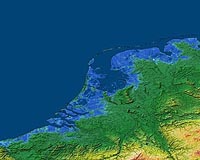| . |  |
. |
Madrid, Spain (SPX) Feb 15, 2010 "Despite improvements in the LCA, it has a methodological weakness, which is a lack of environmental impact categories to measure the effect of human activities such as cultivation or grazing on the soil", Montserrat N´┐Żnez, lead author and a researcher at the Institute of Agro Food Research and Technology (IRTA), tells SINC. The research, published in the latest issue of the International Journal of Life Cycle Assessment, is the first study in the world to include the impact of desertification in the LCA, based on classifying 15 natural areas or "eco-regions" according to their degree of aridity. By simultaneously using the LCA and a Geographic Information System (GIS), the researchers have shown that eight of these 15 areas can be classified as at risk of desertification, representing 38% of the land surface of the world. The eight natural areas at risk are coastal areas, the Prairies, the Mediterranean region, the savannah, the temperate Steppes, the temperate deserts, tropical and subtropical Steppes, and the tropical and subtropical deserts. "The greatest risk of desertification (7.6 out of 10 on a scale produced using various desertification indicators) is in the subtropical desert regions - North Africa, the countries of the Middle East, Australia, South West China and the western edge of South America", the scientist explains. These are followed by areas such as the Mediterranean and the tropical and subtropical Steppes, both of which score 6.3 out of 10 on the scale of desertification risk. Coastal areas and the Prairies are at a lower risk of desertification, with 4 out of 10. "Unsustainable land use may lead to soil becoming degraded. If this happens in arid, semi-arid and dry sub-humid regions, such as Spain, this degradation is known as desertification, and the effects can be irreversible, because they lead to areas becoming totally unproductive", says N´┐Żnez, who worked on the study with scientists from the Autonomous University of Barcelona and the National Technological University in Mendoza, Argentina. In order to establish their methodology, the researchers used four biophysical variables that are the main causes of desertification - aridity, erosion, over-exploitation of aquifers and risk of fire. "This makes it possible to satisfactorily evaluate the impact of desertification of a particular human activity, and compare the impact of the same activity in a different place, or the impact of different activities carried out in the same place", explains the researcher. The methodology proposed by the scientists is currently being put to use in various case studies in Spain and Argentina.
Completing the study of desertification This new methodology will provide the Life Cycle Assessment (LCA) with an environmental impact category that will make it possible to measure "the desertification potential caused by any human activity", adds N´┐Żnez. The Life Cycle Assessment (LCA) is a scientific methodology that objectively analyses the environmental impacts of an activity or process, taking in the full cycle, from extraction of raw materials right through to management of the waste generated at the end of this material's useful life.
Share This Article With Planet Earth
Related Links FECYT - Spanish Foundation for Science and Technology Climate Science News - Modeling, Mitigation Adaptation
 UN panel admits new error in key climate report
UN panel admits new error in key climate reportGeneva (AFP) Feb 14, 2010 The UN climate change panel admitted Sunday to having imprecisely stated in a key report that 55 percent of The Netherlands is under sea level, saying that is only the area at risk of flooding. The Dutch government this month asked the Intergovernmental Panel on Climate Change (IPCC) to explain the figure, used in a landmark 2007 report, saying its numbers were that only 26 percent of the co ... read more |
|
| The content herein, unless otherwise known to be public domain, are Copyright 1995-2010 - SpaceDaily. AFP and UPI Wire Stories are copyright Agence France-Presse and United Press International. ESA Portal Reports are copyright European Space Agency. All NASA sourced material is public domain. Additional copyrights may apply in whole or part to other bona fide parties. Advertising does not imply endorsement,agreement or approval of any opinions, statements or information provided by SpaceDaily on any Web page published or hosted by SpaceDaily. Privacy Statement |